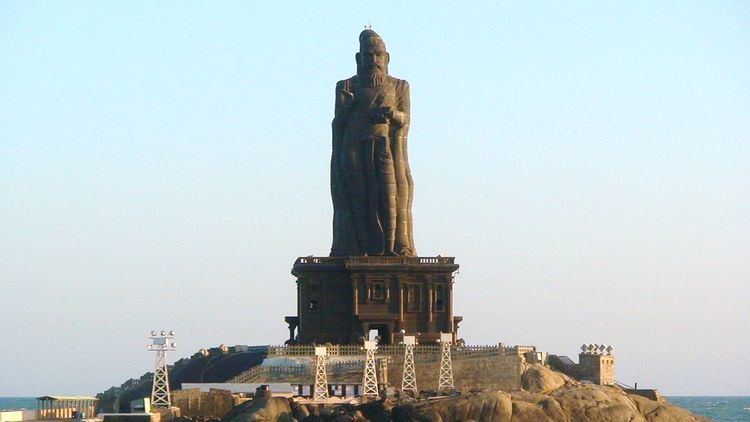Type statue Beginning date 7 September 1990 Opening date 1 January 2000 Height 41 m Designer V. Ganapati Sthapati | Completion date 1999 Opened 1 January 2000 | |
 | ||
Hours Closed now Thursday9AM–4PMFriday9AM–4PMSaturday9AM–4PMSunday9AM–4PMMonday9AM–4PMTuesday9AM–4PMWednesday9AM–4PMSuggest an edit Similar Vivekananda Rock Memorial, Vattakottai Fort, Thanumalayan Temple, Padmanabhapuram Palace, Gandhi Mandapam | ||
Thiruvalluvar statue kanyakumari india
The Thiruvalluvar Statue is a 133 feet (40.6 m) tall stone sculpture of the Tamil poet and philosopher Tiruvalluvar, author of the Thirukkural. It is located atop a small island near the town of Kanyakumari on the southernmost Coromandel Coast, where two seas and an ocean meet; the Bay of Bengal, the Arabian Sea, and the Indian Ocean.
Contents
- Thiruvalluvar statue kanyakumari india
- Thiruvalluvar statue kanyakumari
- Description
- Construction
- Access
- References
Thiruvalluvar statue kanyakumari
Description
The statue has a height of 95 feet (29 m) and stands upon a 38-foot (11.5 m) pedestal that represents the 38 chapters of "virtue" in the Thirukkural. The statue standing on the pedestal represents "wealth" and "pleasures", signifying that wealth and love be earned and enjoyed on the foundation of solid virtue.
The combined height of the statue and pedestal is 133 feet (40.5 m), denoting the 133 chapters in the Thirukkural. It has a total weight of 7000 tons.
The statue, with its slight bend around the waist is reminiscent of a dancing pose of the ancient Indian deities like Nataraja. It was sculpted by the Indian sculptor Dr. V. Ganapati Sthapati, who also created the Iraivan Temple.
Its opening ceremony was on 1 January 2000 (Millennium). The monument was hit by the Indian Ocean tsunami on 26 December 2004.
Construction
In 1979, the then Prime Minister Morarji Desai laid the foundation stone for the statue. However, the installation and the sculpting work began on 6 September 1990, on the tiny island adjacent to Vivekananda Rock Memorial when funds were allocated in the 1990-91 budget. Initially, the project stalled but then recommenced in 1997 and was completed on 1 January 2000. At the cost of more than US$1 million (INR 61.4 million), it employed about 150 workers, sculptors, assistants and supervisors. The slight bend around the waist made the design challenging. Dr. V. Ganapati Sthapati solved the problem by creating a full-length wooden prototype before construction. Study of this prototype led to the identification of an energy line (known in Vastu as kayamadhyasutra), currently an empty cavity in the center of the statue from top to bottom. Sthapati designed the statue to survive earthquakes of unexpected magnitude. This Statue was constructed in the DMK Government period.
The stone work was divided amongst three workshops, in Kanyakumari, Ambasamudram and Sholinganallur. Ambasamudram contributed 5,000 tons of stones, while Sholinganallur was quarried for 2,000 tons of high quality granite stones for the outer portion of the statue. While the largest of the 3,681 stones weighed over 15 tons, the majority weighed three to eight tons. An interesting detail is the 19-foot-high face, with the ears, nose, eyes, mouth, forehead all made of individual stones carved by hand. Stumps of palmyra tree and poles of casuarina (ironwood) were used for scaffolding. It took 18,000 casuarina poles tied together with two truckloads of ropes to reach the top of the statue.
Access
The statue stands 400 meters from the coastline of Kanyakumari on a small island rock. Ferry service are available from the mainland. The ferry service to Vivekananda Rock Memorial stops for a while at the Thiruvalluvar Statue.
